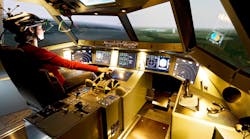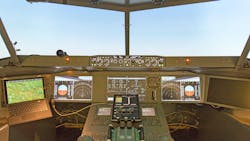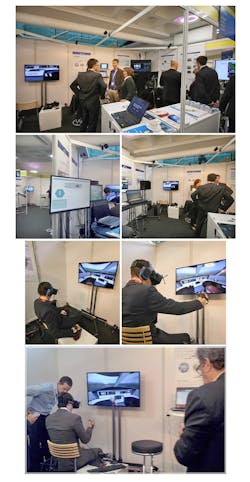In the past 25 years, airlines and the amount of flights per day have risen considerably. In the EU, the number of flights has risen from 360 million in 1993 to almost a billion this year. In the U.S., there are 5,000 aircraft in the sky at any given time, and in 2016 the FAA handled 42,700 flights daily.
As the volume of air traffic continues to rise, experts across the aerospace industry, including companies like Honeywell and the German Aerospace Center, have teamed up to introduced advanced virtual reality (VR)-based autopilot systems. These autopilot systems will help offset the high workload and the burden of stress on pilots.
A-PiMod
The A-PiMod is an EU-funded project that introduces sophisticated software into the cockpit. The software makes recommendations based on the conditions of the aircraft and that of the pilot. It can measure eye movement, gestures, and inputs from the pilot, which allows it to draw conclusions concerning their stress levels. Based on the current workload, it can make suggestions to the pilot adapted for the current situation. It cannot override the pilot’s decisions, but rather, make suggestions to the crew on which tasks they should perform themselves and when the autopilot should take over.
A-PiMod and other intelligent autopilots can help human operators by taking on more tasks, easing the workload on the pilots and their crew.
Systems like A-PiMod could help usher in a more uniform workload for the aviation industry. If intelligent autopilots can help human operators by taking on more tasks, pilots would be less busy during flight. The system has been tested so far only on flight simulators. One potential concern from the pilots is data protection. “The pilots who tested the system were worried about the data the system collects about the performance of the pilots and whether it would be passed on to the airline,”said Dr. Helmut Többen of the German Aerospace Center. He is hopeful, however, that these concerns will in time be resolved, easing pilot worries prior to implementation in commercial aircraft.
i-Vision
Another EU-funded virtual environment program to help pilot aircraft is the i-Vision project; it uses VR to evaluate the cockpit configuration. The i-Vision concept was inspired by Airbus’ wishes to explore flexible and low-cost tools for designing and evaluating future aircraft cockpits. The i-Vision project uses VR simulation to test new cockpit components and how crews would interact with them. By using a VR head display, a finger tracking system, and a flight simulator, the program can analyze a stream of data from the flight instruments and provide insight into the pilot’s behavior.
i-Vision uses virtual reality to test out new cockpit configurations and components to better design future aircraft.
The program also makes use of digital languages, also known as semantic web technologies, which have been specially developed to define and find connections in data that can be easily expressed for machine processing. This eliminates the need for the costly and time-consuming physical mockups for testing. These semantic engines help virtual reality frameworks to be more useful and relevant for collection human operator data, according to Dr. Dimitris Mavrikios of LMS-University of Patras in Greece, leader of the i-Vision project.
“This makes virtual cockpits and interaction with them smarter than simple simulators,” explained Mavrikios. “Virtual reality offers a unique and critical advantage when compared to the more conventional desktop simulation. [It has] the ability to obtain information directly from the user’s actions and behavior during the simulation of a scenario.”
The i-Vision project finished last year and soon will have an impact on how cockpits are developed. Airbus will be using the tool to test new experimental cockpits, taking into account human factors at the very start of the design process.



